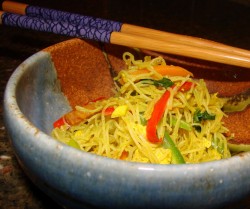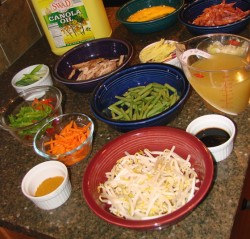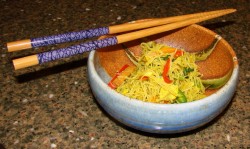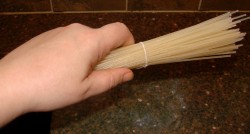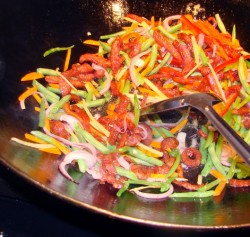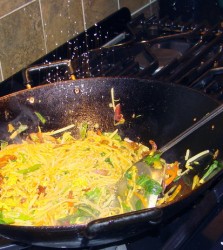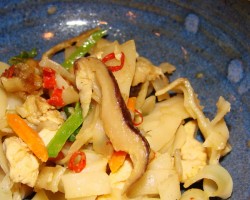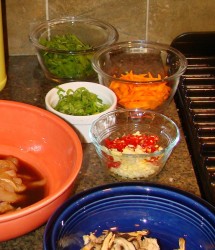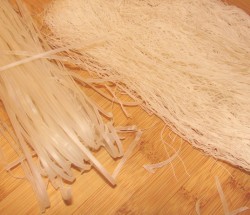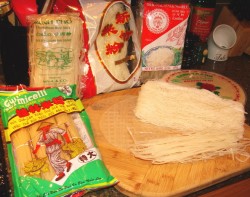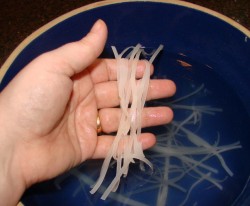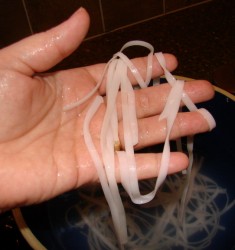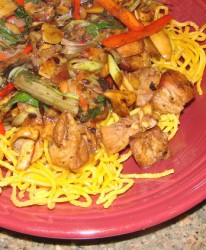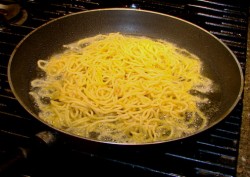Singapore Rice Noodles: Noodles+Curry+Wok=Delicious
These noodles did not originate in Singapore.
Or, at least, that is what I am told. They are Cantonese in origin, possibly from Hong Kong, and they were first very popular in European Chinese restaurants. They made it to the US sometime in the 1980’s and spread through the Chinese-American restaurants to the point where they are now fairly standard menu items.
But, they probably didn’t come from Singapore, where admittedly, there are many Chinese of southern heritage, and where stir-fried rice noodles are a ubiquitous street food.
So, why are they called “Singapore Rice Noodles?” Well, as near as I can figure there are two reasons behind it. One, is because it sounds exotic, and anyone who has worked in a Chinese-American restaurant can tell you that exotic sounding names sell plates of food. Servers can tell you that, as can chefs and owners who make up these names–people just really like stuff that sounds like it came from a far-away, interesting place.
The second reason has to do with one of the primary seasoning ingredients: curry powder.
Curries are popular in Singapore, it being along the trade route between India and China, so the logic in naming the noodles probably had something to do with the use of curry powder in the dish. Even though the curries of Singapore use other ingredients besides curry powder in them–curry was apparently curry to the cook who named this rice vermicelli stir fry.
The truth is, I don’t really give a darned about why these delectable noodles are named after Singapore. The ironic thing about this dish is that while it wasn’t originally from Singapore, it was a Singaporan Chinese culinary arts student named NeeWee who got me addicted to eating it. NeeWee said himself that he knew they didn’t come from Singapore, but he didn’t really care–they tasted so good he was happy to claim them as authentic Singaporan cuisine. Besides, as he said, he was Chinese, and they were certainly Chinese, so they were part of his heritage anyway, so he might as well enjoy them every chance he got.
And enjoy them he, and then later, I, did. Once he got me to taste them, there was no going back. I crave the little saffron-colored strands of chewy-soft noodles which have lightly crisped on the edges like a horse craves clover. Sprinkled among the tangled nest of noodles like jewels in a jackdaw’s nest lay morsels of Cantonese roast pork, shreds of onion, scallion top, and sweet pepper, silvery bean sprouts and tiny curled pink shrimp. At our request, shreds of chili pepper would join these sweeter flavors, along with the hot chili oil with seed we would drizzle over the serving platter with abandon, bringing a fire to our tongues and a light to our eyes.
Neewee, myself and our friends had a lot of fun sharing platters of Singapore Rice Noodles; we’d go out to a favorite Chinese restaurant after class and gulp down platters of them, and guzzle pot after pot of tea while we laughed over the events of our day, talking culinary triumph and disaster, and arguing philosophy and food. It is because of Neewee that I eventually had to learn how to make these delicious noodles–here in Athens, there is no place I can go to get a decent plate of them otherwise.
I have, of course, made a few modifications, and I do so with no feelings of guilt or sense that I am violating a traditional recipe. For one thing, I have eaten Singapore Rice Noodles at enough restaurants to know that there is no singe standard recipe. The only constants seem to be rice vermicelli, curry powder, onion slices, red or green bell pepper slices, bean sprouts, and possibly shrimp. I have eaten menu versions which have had or lacked roast pork, chicken, scrambled egg, chile peppers, carrots, mushrooms, scallions and chile peppers. That is a pretty wide variation in ingredients–wide enough that to me, it means there is no one traditional recipe by which this dish is known, which can be held up as the standard of authenticity.
So, I feel no great angst over adding more vegetables to my version and using, instead of shrimp, and in addition to my own roast pork, Chinese lop cheong–sweet pork sausages. Zak doesn’t much care for stir fried shrimp, so I figured the sweet flavor of the air dried lop cheong would make a good substitute, as I find tiny shrimp to have a very sweet taste as well. (When I asked for the lop cheong at the local Asian market, I got teased by the owners for using Cantonese pronunciation instead of Mandarin. Ah, well. That is what I get for learning my Chinese by watching too many Hong Kong movies–Cantonese pronunciation.)
I also did experiment with one change which I suspect rendered the dish no longer Singapore Rice Noodles, but instead something along the lines of “Stir Fry Curry Noodles.” I used Guilin rice noodles–which look like rice spaghetti–instead of the traditional hair-fine rice vermicelli. These thicker noodles, pictured as they came out of the package here, made a very different dish–the noodles were not mushy, but were soupier, with a slippery texture–this is in large part because I added more liquid than was necessary to the wok to cook them. As the noodles cooled in our bowls while we ate them, they became more chewy and reminiscent of the proper texture of Singapore Rice Noodles, but they still were not what I considered right and proper.
It was tasty, but not properly what I would call Singapore Rice Noodles.
A word of warning, before we delve into the recipe. If you look at recipes for this dish in cookbooks and especially online, they usually counsel you to use way more liquid than is necessary to cook the noodles in the wok. The essence of this recipe is a balance between heat and liquid–too much heat and not enough liquid, and you will get oddly plastic-like too chewy noodles. Too little heat and too much liquid, and you will get slippery, soft and somewhat soupy noodles instead of properly chew-soft stir fried noodles.
It is a difficult balancing act to pull off, but in my recipe, I advocate the use of much less liquid than any other recipe I have found. However, when cooking with rice vermicelli, I have found that less is more–the amount of liquid I used was just enough to carry the curry powder flavor into the noodles and infuse them with the saffron color of turmeric. This softens the already soaked noodles just enough to soak up the flavors of the wok without making them slippery soft and overcooked.
The vegetables and meats you use are up to you. The ones listed are just the ones I happened to use this time around. If you are a vegetarian, substitute some pressed spiced tofu or some smoked tofu (or both) for the meats, and add some soaked Chinese black mushrooms to the mixture as well for their meaty texture and flavor. Use either vegetable broth or the soaking liquid from the mushrooms for the chicken broth. If you are a vegan, follow my suggestions for the vegetarians and just leave out the eggs.
However you make Singapore Rice Noodles, just remember to use rice vermicelli and plenty of good-tasting curry powder. The one I use is a combination of Penzey’s sweet curry powder and hot curry powder. (That mixture tastes really good in scrambled eggs and deviled eggs, too, though I never make curry with it at all.)
Please don’t be put of by the long ingredient list. That is mostly because I like lots of vegetables in my noodles. You don’t have to use so many as that. But if all the cutting doesn’t frighten you, try it my way, especially now when summer produce is at its height. I don’t think you will be sorry.
Ingredients:
12 ounces rice vermicelli
3-5 tablespoons peanut or canola oil
4 ounces lop cheong, cut on the diagonal into thin slices, then each slice cut into slivers
1/2 cup julienne slices purple onion
1/2 cup julienned carrot
1/2 cup julienned sweet bell pepper
1/4 cup thin green beans, cut on the diagonal the same size as the other vegetables
1/4 cup snow peas, stringed and cut on the diagonal in thin slices
4 ounces Chinese roast pork, cut into thin strips
2 eggs lightly beaten
3 tablespoons minced garlic
2 tablespoons minced fresh ginger
2-3 fresh hot chilies, sliced thinly on the diagonal (optional)
2 1/4 tablespoons Madras or other yellow colored curry powder
1 teaspoon raw or brown sugar
1/4 teaspoon salt
2 tablespoons thin or light soy sauce
1 tablespoon Shao Hsing wine
1/4 cup chicken broth, divided into two halves
1/2 cup bean sprouts, root ends picked off, rinsed and drained
1/4 cup thin diagonal slices scallion tops–dark green part only
1/2 cup cilantro leaves, rinsed and drained
1 teaspoon sesame oil
salt to taste
Method:
Soak the vermicelli in warm water to cover until they are thoroughly softened. This should take about a half hour to forty-five minutes. After they are thoroughly softened, drain them until they are needed in the stir fry.
Heat wok until it smokes; add two tablespoons oil and allow to heat for fifteen to thirty seconds.
Add lop cheong, and stir fry until it begins to curl and brown and renders its own fat. At that point, at the onion slices, and stir fry about one minute. Add carrots, stir fry another thirty seconds, then add the rest of the vegetables and stir fry for about a minute and a half. Add pork, stir fry another half minute or so, just to warm the pork.
Scrape contents of the wok into a clean bowl. Return wok to heat and if needed add another tablespoon of oil. Allow oil to heat for fifteen seconds, then add eggs, and stir fry until dry scrambled. Add this to the bowl of vegetables and meats.
Add another tablespoon of oil to wok. Allow to heat fifteen seconds, then add ginger, garlic and chilies, if you are using them. Stir fry until fragrant, about thirty seconds to a minute, then add sugar, salt and curry powder. Continue stir frying for another thirty seconds, then add the soy sauce, wine and 1/8 cup of the chicken broth.
Immediately add drained noodles, and stir and fry, working the liquid into the noodles. As the yellow color of the curry powder imbues the white noodles with flavor and tint, keep stirring. You will notice the noodles will shrink in volume slightly. At this point, you will see that the liquid that is not being absorbed by the noodles is being evaporated, and the noodles may begin to stick to the wok. If this happens, add the rest of the cooking oil, and keep stirring. What you want to see is the noodles begin to dry slightly, becoming a bit chewy. If they are too dry to your taste, add more chicken broth, a tablespoon at a time, from the reserved 1/8 cup of it. (I don’t usually need to do this, but you might. When I make these noodles, I always only use the 1/8 cup of chicken broth and no more–but your stove may be hotter.)
At this point, add the cooked meats, veggies and eggs to the wok and stir to combine. This takes good shoulder and forearm muscles–the noodles don’t like to be friendly at this point, and everything feels heavy. Keep working and you will prevail. Add the bean sprouts, scallions and cilantro, and the drizzle of sesame oil and take wok off heat. Stir these last bits int, and taste for salt, adding more as needed.
Serve steaming hot from the wok, but be aware that this is really good as cold leftovers from the fridge. I like them that way for breakfast or lunch, though I bet they would be good folded into an omelet, too.
Hunan Rice Noodles With Chicken and Salted Chilies
I found this recipe originally in Fuchsia Dunlop’s amazing Revolutionary Chinese Cookbook, which is the simply best book on the subject of Hunan cookery published in English. It uses salted chilies, a condiment which is ubiquitous to Hunan, but which is not available in stores here int he US; instead, Dunlop gives a simple recipe to make them yourself.
It had been two weeks since I started the chilies fermenting, and now they were ready; of course, I had to use some right away in order to experience the flavor which I had been watching develop for fourteen days.
Dunlop’s original recipe only included Chinese black mushrooms and bean sprouts as vegetables; while this minimalism is authentic, I wanted a bit more color and crunch in my version, not to mention a bit more fiber and vitamins, since I was making a one-dish meal. So, I added carrots and snow peas to the dish, sliced into diagonal julienne, and threw in some cilantro leaves for good measure.
The only other ingredient I added was a scant 1/8 cup of chicken broth; I have found that adding a tiny bit of liquid to the noodles as they stir fry leads to a velvety texture that is lush on the inside while still being toothsomely chewy on the outside. That dash of chicken broth also adds a measure of chickeny flavor that permeates the entire dish, making it particularly savory in flavor.
A vegetarian version could be made by using the soaking liquid from the mushrooms in place of the chicken broth, and by replacing the chicken with either wheat gluten (seitan) or pressed spiced or smoked tofu.
I was pleased by the results.
At first, I thought that the chilies turned out not to be spicy at all; however, this was just not the case. They were spicy, but the fermentation took their inherent “in-your-face” heat and transformed it into a more subtle, “sneaks-up-on-you” bite, which after about three tastes, I found to be quite enjoyable. This more subtle salty-tangy heat allowed more of the flavors of the chicken, mushrooms and vegetables, all supported by the Shao Hsing wine and sesame oil to shine forth like savory beacons on the tongue. The ginger, garlic and scallion tops all contribute their shimmering nuances, creating an elaborate dance of flavors in a relatively simple, homey noodle dish.
This one is destined to be made again and again, so long as the salted chilies hold out.
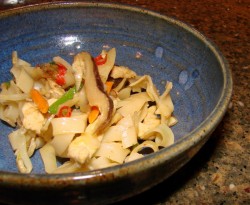
Hunan Stir-Fried Noodles With Chicken and Salted Chilies
Ingredients:
1 boneless skinless chicken breast, trimmed and cut into very thin slivers with the grain of the meat
1/2 teaspoon sugar
1/4 teaspoon salt
2 teaspoons light or thin soy sauce
1 tablespoon Shao Hsing wine
1 tablespoon soaking liquid from mushrooms
2 tablespoons cornstarch
3-5 tablespoons peanut or canola oil
3 teaspoons finely minced fresh ginger
4 teaspoons finely minced fresh garlic
2 teaspoons salted Hunan chilies
8 dried Chinese black mushrooms (shiitake), soaked for twenty minutes in boiling water, stems removed and thinly sliced
2 carrots, peeled and cut julienne
1/4 pound snow peas, stringed and cut into diagonal julienne
1 cup fresh bean sprouts, roots removed
1 pound package 1/2 inch wide dried rice noodles, soaked in hot water until fully pliable, then drained
2 teaspoons thin or light soy sauce
scant 1/8 cup chicken broth or stock (or use soaking liquid from mushrooms)
3 scallion tops, dark green part only, cut into very thin diagonal slices
1/2 cup loosely packed cilantro leaves
scant teaspoon sesame oil
salt and freshly ground white pepper to taste
Method:
Toss cut chicken with the next six ingredients in a bowl. Allow to marinate for at least twenty minutes while you prepare the rest of the ingredients.
Heat wok until smoking. Add smaller amount of cooking oil, and allow to heat for about ten to twenty seconds.
Scoop the chicken from the bowl, leaving behind any liquid marinade that does not cling to the chicken. Reserve marinade. Place chicken in wok, spread to make it cover the bottom of the wok in as close to a single layer as possible, and leave undisturbed to brown lightly for about thirty seconds to one minute. Spread the ginger, garlic and chilies over the top of the chicken.
When chicken is browned, begin stir frying vigorously. Add mushrooms immediately, and keep stir frying until only about 1/3 of chicken shows raw pink color; the rest should be white and pale golden. Add carrots, and continue stir frying for about thirty seconds.
Add snow peas, and then the drained noodles. If necessary, at this time, you may add oil. (The mushrooms sometimes soak up oil.) Also, if at any time the noodles begin to stick very much, you may add the rest of the cooking oil to the wok. Splash soy sauce and chicken broth down the sides of the wok and stir fry the noodles until they become softer, and are a delicate yellowish brown color.
Add the bean sprouts, scallion tops, cilantro and sesame oil and continue stirring. As soon as the noodles are done cooking, take the wok off heat, and taste. If needed, add more salt and some pepper, stirring to combine well before serving.
Serve piping hot, while still imbued with wok hay–the scent of the wok. This will serve four people of average appetites, or three heavy eaters. Leftovers reheat beautifully in the microwave in about two minutes.
Dried Rice Noodles 101
Dried rice noodles, also known as rice sticks in English and pai mi fen in Mandarin, are available in nearly any Asian market, and in many American grocery stores in either the international foods sections or the health food aisle. Widely used in China, Thailand, Vietnam, Singapore and Indonesia, dried rice noodles come in a myriad of sizes and shapes.
From the nearly hair-fine crinkly strands of rice vermicelli illustrated above to flat fettuccine-shaped noodles a half-inch wide, these translucent, brittle dried noodles can be used in a variety of dishes, including cold salads, stir fries and soups. Depending on the cooking method, the texture of these noodles can be tender or chewy, slippery or firm, but they are always smooth and satisfying.
Their own inherent flavor is mild, so rice noodles make the perfect canvas for a nearly endless variety of sauces, broths, and condiments. They are equally at home in dishes mild and comforting as they are supporting a cast of fiery and flavorful ingredients.
Rice noodles are among the most versatile standards of the Chinese pantry, which is wonderful, because they are also astoundingly inexpensive. Only a dollar or so per pound, dried rice noodles are an easy way to feed a whole houseful of family and friends cheaply.
There are many brands on the market, not all of them Chinese in origin. That doesn’t really matter–rice noodles are rice noodles, whether they are made in Vietnam and labeled banh pho or Thailand where they are called kui teow. What matters is that you choose a shape and size that works with your recipe, and then treat them properly before you cook with them.
The best dried rice noodles are made only of rice and water. These will have the best texture; the ones which have cornstarch or other starches added are of inferior quality, and will be more likely to have a mushy texture when cooked. They are, in my opinion, not worth the money you pay for them.
Before cooking rice noodles, they must be soaked in water to soften them. Even if you are planning on boiling the noodles or serving them in soup, they must be soaked to the proper texture before you attempt to cook them. For wide or thick noodles, very hot to boiling water is used to soak them; for very thin or rice vermicelli, use warm to cold water. The length of time you have to soak the noodles will depend on how warm the water is; the hotter the water, the less time it takes for them to soak. (However, remember, if you use boiling water on rice vermicelli to soak it–you may wind up overcooking the very thin, fine noodles instead of soaking them to the proper texture–so be forewarned!)
What exactly is the proper texture for soaked rice noodles? Well, it is easiest to refer to the photographs above and below this paragraph. The one above shows noodles that are not finished soaking–they are softened, and they have turned from translucent to white, but as you can see, they are still somewhat stiff and only slightly pliable. If you were to try and use these noodles in a stir fry as they are now, they would be tough, chewy and overly crisped on the edges, and would not be very appealing at all. In a soup, they would be equally unpalatable, as they would lack smoothness and tenderness. If you attempted to boil them to the proper texture, it is likely that you may overcook them, as rice noodles can go from perfection to mush within a split second. In order to shorten the boiling process down to a bare minute or less, it is best to soften the noodles completely before cooking them.
In the photograph below, you see rice noodles which have soaked the proper amount of time. They are fully softened to easy pliability, they drape gracefully from the hand like pale ribbons. At this stage, it will only take a minute’s worth of a dunk in a pot of boiling water or a good tossing in a wok of hot oil to finish the cooking process.
In order to soak them, it helps to have a large bowl where the noodles can spread out and have plenty of room. Just cover the noodles with hot or cold water, as needed and make certain every noodle is completely under the water. Swish them around now and again to separate them and to test their readiness.
To boil rice noodles to be used in soups or in cold noodle dishes, soak them until they are soft, and then drain them. Bring water in a large pot to a boil, and drop the noodles in. Start timing the noodles, and cook for no more than a minute. I usually remove them as soon as the water comes back to the boil. Check for doneness–they should be soft and pliant without being mushy.
Then drain and rinse in cold water. For cold noodle dishes, toss immediately with the dressing after being rinsed, for soup noodles, warm them immediately in boiling soup after rinsing. Rinsing removes extra starch from the surface of the noodles and keeps them from being a bit gummy.
For noodles destined to be stir-fried, the noodles only need to be soaked. If they feel starchy when they are finished soaking, they can be rinsed before draining them. I usually drain them for at least ten minutes before they are due to hop into the wok to get most of the water off of them, but if I lack that amount of time, I have been known to pat them dry with paper towels. They do not need to be perfectly dry, however, because a little bit of water clinging to them helps steam them a bit as they go into the wok, which helps cook them further, resulting in a more tender yet chewy noodle.
While I am very fond of rice noodles in both soups (the ubiquitous Vietnamese pho being an obvious example) and as cold noodles, my favorite dishes with them are stir-fried. Unfortunately, many restaurants use more oil than is absolutely necessary to get a good result with stir fried rice noodles, so many have the mistaken notion that fried rice noodles must just by necessity be greasy. This is not the case, as I hope to illustrate over the next few posts.
Before we are finished discussing the basics of dried rice noodles, I have to mention that a classic way of serving rice vermicelli is as a crispy garnish or appetizer, deep fried. To fry them, the noodles need only be separated while dry, and then dropped into a wok filled with hot oil. There, they puff up dramatically into snowy-white crispy nests. These are used as garnishes atop stir fries, or as a bed for a spicy stir fry or are mixed into a dry fried beef dish which is eaten as an appetizer in Sichuan province wrapped in lettuce leaves.
Those are the basics about dried rice noodles. Fresh rice noodles are another topic altogether, which I will treat at length in a later article. For now, I hope your appetite is whetted for the rice noodle recipes to come.
Technical Difficulties
Hello, friendly readers.
The reason there have been no updates is that we are having technical difficulties with our computers and network.
Other than that, all is well here.
Hopefully, soon, there will be regular updates again.
Two-Sides-Brown: Pan-Fried Noodle Pancake
This recipe is not often found on the typical American Chinese restaurants, and that is a shame, because it is a delicious dish, filled with textural and flavor contrasts.
I used to eat it at the Chinese restaurant where I worked, and I loved watching the chefs cook the pancakes; they used a large wok and a great deal of oil to turn boiled, drained fresh egg noodles into a round or oval nest of loops and whorls, crispy on the outside and chewy-velvety on the inside.
One chef told me that he grew up calling the noodle pancakes “two-sides-brown,” a poetic name describing how the noodles look after being cooked. His grandmother made them for special dinners, he said, and she made her toppings only of seafood.
Yes, once these noodles are fried into cake-like rounds or ovals, they can be kept warm in an oven. Then, a topping of meat, seafood, tofu, or vegetables with a lot of sauce is prepared in a wok. The noodles are then placed on a serving platter and the topping is poured over it to be served immediately.
The noodles can be cut into wedges before pouring the topping over them or, they can be pulled apart with chopsticks by the diners. I think that cutting them is easiest–after cutting, you can reassemble the cakes, and then pour the topping over it to cover where it has been cut. Then, diners can nab portions with a serving spoon or chopsticks and place them in their own individual bowls or plates.
This is an easy, yet complex-looking dish to prepare; making the pancake is not that hard, especially if you use steamed noodles to make it. With thin steamed noodles, you do not have to further cook them before frying the cake; otherwise, the recipe can be made with boiled fresh egg noodles which have been rinsed in cold water, thoroughly drained and then tossed with one tablespoon each soy sauce and sesame oil to flavor them and to keep them from sticking. Thick steamed noodles should also be pre-boiled as well to soften them completely.
The steaming and/or boiling can be done hours ahead of time. Just cook, rinse, and toss with the soy sauce and sesame oil, then seal in a plastic bag and refrigerate them until needed.
One the pancakes are cooked, they can be held in a 150-200 degree F. oven for an hour if needed. That way, they can be pulled out, and a fresh topping can be poured directly from the wok onto the warm noodles, and the dish can be rushed to the table while the scent of the wok drifts from the steaming platter to the quivering nostrils of the diners. The dish looks impressive and tastes wonderful–and that is all that is needed to make a memorable dinner.
There are mistakes to be made, of course. The first time I made a noodle pancake, I used thicker steamed noodles and neglected to pre-boil them. They turned out too crisp and hard. I also used too few noodles to make too wide of a pancake, so it wasn’t thick enough to have the proper yielding texture in the middle. I corrected these problems with my second batch, however, now I am pleased to be able to make a favorite dish which I seldom see on Chinese restaurant menus.
And a word about the topping. I am giving no topping recipe, because you can use any stir-fry recipe to make a topping so long as plenty of sauce is involved. The sauce soaks into the noodles a bit, softening the crispy crust of them and flavoring the silky, chewy inner parts. Instead of giving you one recipe for a topping, at the end of the recipe, I will give links to stir-fried dishes I have already presented which would make great toppings for your very own noodle pancake dish. (The pork lo mein recipe I am giving is to be used sans the noodles given for the lo mein. Obviously, one would not top noodles with more noodles.)
One more caveat–this is an oily dish by nature. As such, I think it is important to pair it with less rich fare, such as steamed vegetables or clear soups so as to not overburden the stomach with a lot of heavy foods in the same meal. One could also drink pu er tea with the meal–the earthy, slightly bitter quality of the tea is very good for cutting through rich flavors and cleansing the palate. It also acts as a stimulant to aid digestion.
Pan-Fried Noodle Pancake
Ingredients:
1 pound steamed or plain fresh Chinese egg noodles
1 tablespoon sesame oil
1 tablespoon light soy sauce
4 tablespoons canola or peanut oil
Method:
If the steamed noodles are very fine and thin, you can just go ahead and fry them. The way to go about this is to put two tablespoons of oil in a wide, heavy-bottomed nonstick skillet over medium heat. When it is hot, gently lower the steamed noodles into the oil, spreading them out with your fingers (be deft and careful here!) a pair of chopsticks or a set of tongs, into a round disk-like shape, flattening it into a pancake. Sprinkle 1/4 cup of water over the noodles, and then cover the pan and cook for about five minutes. Then, turn the pancake over, add the other two tablespoons of peanut or canola oil and cook on the second side for another five minutes, or until it is brown.
Now–I will say that this is a splattery, messy way to go about making the noodle pancake–it spatters like mad when you sprinkle the 1/4 cup of water over it.
So, I suggest that you just boil your steamed or unsteamed noodles as directed here until they are just a tiny bit softer than al dente. Then drain and rinse them thoroughly in cold water, and drain them thoroughly again. Toss them with the sesame oil and light soy sauce, and then either start making the pancake immediately, or place the prepared noodles into a plastic bag in the fridge to wait until you are ready.
When you are ready, heat two tablespoons of the oil in a wide, heavy-bottomed nonstick frying pan. When it is hot, carefully lay the noodles into the pan, shaping them into a pancake with fingers, chopsticks or tongs. Press them down with a spatula to compact them slightly and get them to stick together. They will still sputter a bit, but not as badly as they would if you sprinkled them with water as in the first method. Cook until browned on the bottom, about five minutes.
To turn it over, I use a spatula in my off hand (left hand) and tongs in my right. I pick up one edge of the pancake with the tongs, sliding the spatula under, and with the courage of my convictions (as Saint Julia would say) and a prayer to the Kitchen God, I carefully flip it over. You can do it this way, you can try tossing it in the pan, or you can slide it out onto a plate, then invert the plate over the pan. Whatever works is fine for me.
After it is turned over, add the rest of the peanut or canola oil and cook that side, pressing down with a spatula a couple of times, until it is browned–about five more minutes.
Remove from the pan and drain on paper towels. Set on a serving platter, and if you wish, cut into wedges, then reassemble them on the platter, and put into a 150-200 degree F oven to hold until serving time.
Here are some stir fried dishes that would be good as toppings; whatever stir fry recipe you use, either make certain it is one that makes lots of sauce, or add more saucy stuff to make plenty of juicy goodness to soak into the noodle pancake.
Stir Fried Dry Tofu with Pork
Morganna’s Simple Vegetable Stir Fry
Chicken with Gai Lan and Oyster Sauce
Beef With Mango
Peng’s Homestyle Beancurd
Powered by WordPress. Graphics by Zak Kramer.
Design update by Daniel Trout.
Entries and comments feeds.

